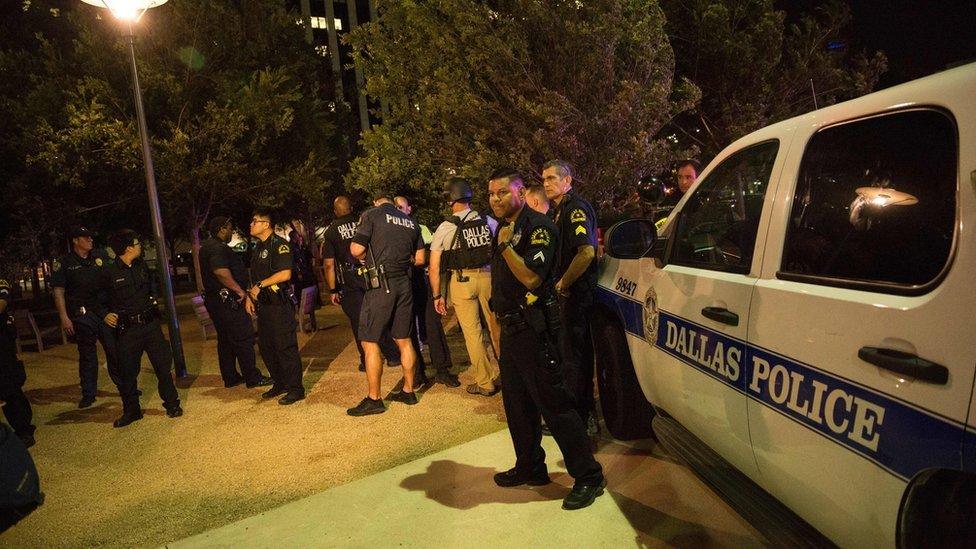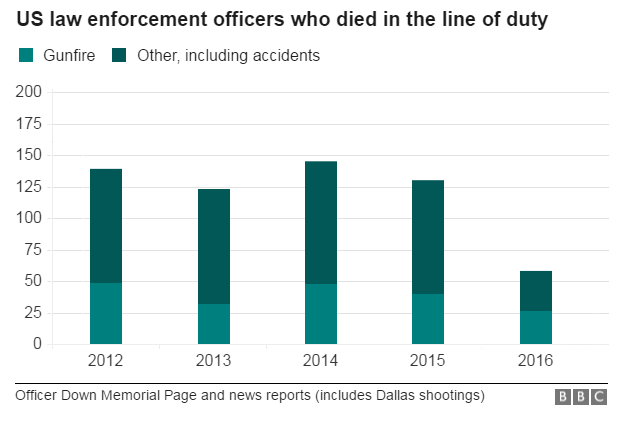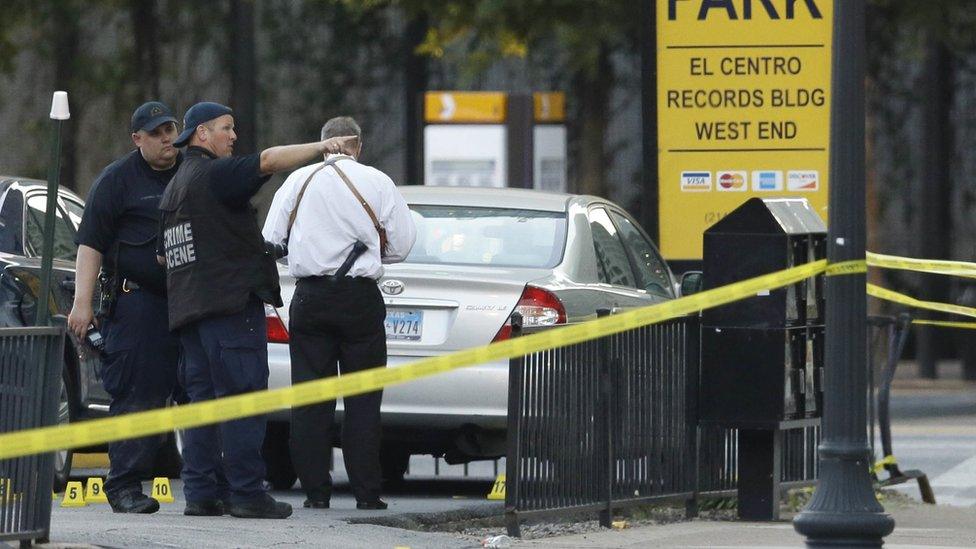In the line of duty: How often are US police killed?
- Published

Five police officers were killed in a deadly ambush at a Dallas protest
The US is reeling after a week of shootings, ending with a deadly ambush on police that left five officers dead and seven others injured in Texas.
The attack, which took place at a Dallas protest over recent police shootings in Louisiana and Minnesota, is considered the deadliest day for US police in the country since the 9/11 attacks, according to records, external published by the National Law Enforcement Officers Memorial Fund.
The gunman, 25-year-old Micah Xavier Johnson, told negotiators he was upset about police killings of black people and wanted to kill white officers.
But as the nation continues a conversation on racism and police relations, Thursday's attack highlights the dangers that officers face in the line of duty.
How often are police killed?

So far in 2016, 56 US law enforcement officers have died in the line of duty, 26 of whom were killed by gunfire, according to data from the Officer Down Memorial Page.
However, experts say annual totals can be misleading.
David Harris, a University of Pittsburgh law professor, says we cannot predict how many police killings will take place through the remainder of 2016, which makes it difficult to determine if police killings are on the rise.
"Trends are up and down year to year," he says.
For example, 2015 marked a record low with 16 officers killed by gunfire during the first six months, which makes 2016 look particularly high in comparison, says Seth Stoughton, a former policeman and University of South Carolina law professor.
However, over the last 10 years, an average of 27 officers were killed by gunfire that was not accidental during the same period, according to Mr Stoughton, citing the FBI's Law Enforcement Officers Killed and Assaulted, external data.
"You have to look at longer term trends," Mr Stoughton says. "At best, comparing two years of information is useless and at worst, it's misleading."
The number of police fatalities in the US is a lot higher than the UK.
The average number killed annually since World War Two is between three and four, according to the Police Roll of Honour, external, although this figure excludes those killed during the Troubles in Northern Ireland.
Why does it fluctuate?
While police officer deaths have been more frequent in recent years, they are still rare, Mr Stoughton adds.
FBI data shows that the average number of officers killed feloniously (not accidental or due to a medical emergency) is on an overall downward trend.
The decrease can be attributed to several factors, including better police training, equipment and medical care.
However, there is a perception that the US has seen more ambush-style attacks on officers such as the incident in Dallas, Stoughton says.
For example, two of the deadliest days in law enforcement history took place in 2009.
Four members of the Lakewood Police Department in Washington state were shot and killed in an ambush attack by a lone gunman in November 2009.
In March of the same year, four members of the Oakland Police Department in California were shot and killed by the same gunman in two related incidents.
"The type of violence against police is viewed as changing," Mr Stoughton says, adding that the US often focuses on high-profile police deaths.
Though the number of officer deaths is decreasing, the rise and fall of totals each year makes the number look more dramatic than it actually may be.
How do police prepare themselves?
There is no universal standard for police equipment, however, a vast majority of officers are equipped with a firearm.
The Law Enforcement Officers Safety Act (LEOSA) allows officers to carry a concealed firearm in any jurisdiction in the US, regardless of state or local laws, with certain exceptions.
Some police departments also use bullet proof vests, pepper spray, Tasers and other conductive electricity weapons as well as bean bag shot guns.
While experts say police officers are prepared to handle situations like the gunman in Dallas, there is some training many police departments neglect to offer.
"Some officers are not adequately prepared to understand that building good relationships with the communities they serve is an officer safety issue," Mr Stoughton says.

Dallas police have secured the area around the scene of the shootings
The long term relationship between police and community is essential to officer safety, he says.
Too often an officer is trained to treat every situation as if it's a deadly encounter.
"The problem is there is so much preparation about the possible presence of deadly dangers that every encounter becomes confused with the idea that it can turn deadly in a heartbeat," Mr Harris adds.
"The first rule in law enforcement is to make it home at the end of your shift," Mr Stoughton, a former officer says. "That doesn't make me want to go out and build long-term relationships with people."
Reporting by Courtney Subramanian